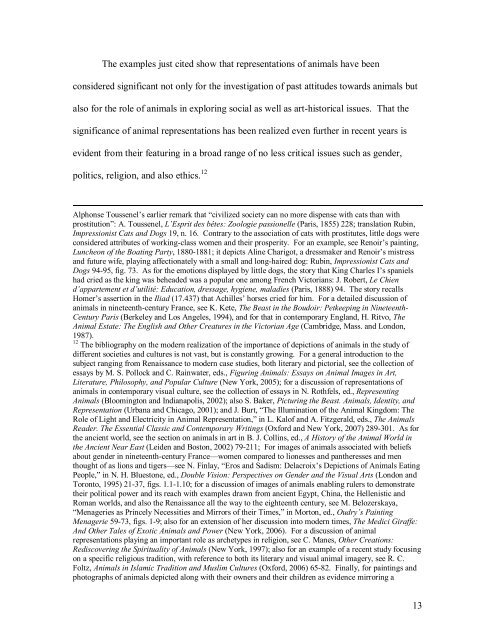The Judgment of Animals in Classical Greece: Animal Sculpture and ...
The Judgment of Animals in Classical Greece: Animal Sculpture and ...
The Judgment of Animals in Classical Greece: Animal Sculpture and ...
Create successful ePaper yourself
Turn your PDF publications into a flip-book with our unique Google optimized e-Paper software.
<strong>The</strong> examples just cited show that representations <strong>of</strong> animals have been<br />
considered significant not only for the <strong>in</strong>vestigation <strong>of</strong> past attitudes towards animals but<br />
also for the role <strong>of</strong> animals <strong>in</strong> explor<strong>in</strong>g social as well as art-historical issues. That the<br />
significance <strong>of</strong> animal representations has been realized even further <strong>in</strong> recent years is<br />
evident from their featur<strong>in</strong>g <strong>in</strong> a broad range <strong>of</strong> no less critical issues such as gender,<br />
politics, religion, <strong>and</strong> also ethics. 12<br />
Alphonse Toussenel’s earlier remark that “civilized society can no more dispense with cats than with<br />
prostitution”: A. Toussenel, L’Esprit des bêtes: Zoologie passionelle (Paris, 1855) 228; translation Rub<strong>in</strong>,<br />
Impressionist Cats <strong>and</strong> Dogs 19, n. 16. Contrary to the association <strong>of</strong> cats with prostitutes, little dogs were<br />
considered attributes <strong>of</strong> work<strong>in</strong>g-class women <strong>and</strong> their prosperity. For an example, see Renoir’s pa<strong>in</strong>t<strong>in</strong>g,<br />
Luncheon <strong>of</strong> the Boat<strong>in</strong>g Party, 1880-1881; it depicts Al<strong>in</strong>e Charigot, a dressmaker <strong>and</strong> Renoir’s mistress<br />
<strong>and</strong> future wife, play<strong>in</strong>g affectionately with a small <strong>and</strong> long-haired dog: Rub<strong>in</strong>, Impressionist Cats <strong>and</strong><br />
Dogs 94-95, fig. 73. As for the emotions displayed by little dogs, the story that K<strong>in</strong>g Charles I’s spaniels<br />
had cried as the k<strong>in</strong>g was beheaded was a popular one among French Victorians: J. Robert, Le Chien<br />
d’appartement et d’utilité: Education, dressage, hygiene, maladies (Paris, 1888) 94. <strong>The</strong> story recalls<br />
Homer’s assertion <strong>in</strong> the Iliad (17.437) that Achilles’ horses cried for him. For a detailed discussion <strong>of</strong><br />
animals <strong>in</strong> n<strong>in</strong>eteenth-century France, see K. Kete, <strong>The</strong> Beast <strong>in</strong> the Boudoir: Petkeep<strong>in</strong>g <strong>in</strong> N<strong>in</strong>eteenth-<br />
Century Paris (Berkeley <strong>and</strong> Los Angeles, 1994), <strong>and</strong> for that <strong>in</strong> contemporary Engl<strong>and</strong>, H. Ritvo, <strong>The</strong><br />
<strong>Animal</strong> Estate: <strong>The</strong> English <strong>and</strong> Other Creatures <strong>in</strong> the Victorian Age (Cambridge, Mass. <strong>and</strong> London,<br />
1987).<br />
12 <strong>The</strong> bibliography on the modern realization <strong>of</strong> the importance <strong>of</strong> depictions <strong>of</strong> animals <strong>in</strong> the study <strong>of</strong><br />
different societies <strong>and</strong> cultures is not vast, but is constantly grow<strong>in</strong>g. For a general <strong>in</strong>troduction to the<br />
subject rang<strong>in</strong>g from Renaissance to modern case studies, both literary <strong>and</strong> pictorial, see the collection <strong>of</strong><br />
essays by M. S. Pollock <strong>and</strong> C. Ra<strong>in</strong>water, eds., Figur<strong>in</strong>g <strong><strong>Animal</strong>s</strong>: Essays on <strong>Animal</strong> Images <strong>in</strong> Art,<br />
Literature, Philosophy, <strong>and</strong> Popular Culture (New York, 2005); for a discussion <strong>of</strong> representations <strong>of</strong><br />
animals <strong>in</strong> contemporary visual culture, see the collection <strong>of</strong> essays <strong>in</strong> N. Rothfels, ed., Represent<strong>in</strong>g<br />
<strong><strong>Animal</strong>s</strong> (Bloom<strong>in</strong>gton <strong>and</strong> Indianapolis, 2002); also S. Baker, Pictur<strong>in</strong>g the Beast. <strong><strong>Animal</strong>s</strong>, Identity, <strong>and</strong><br />
Representation (Urbana <strong>and</strong> Chicago, 2001); <strong>and</strong> J. Burt, “<strong>The</strong> Illum<strong>in</strong>ation <strong>of</strong> the <strong>Animal</strong> K<strong>in</strong>gdom: <strong>The</strong><br />
Role <strong>of</strong> Light <strong>and</strong> Electricity <strong>in</strong> <strong>Animal</strong> Representation,” <strong>in</strong> L. Kal<strong>of</strong> <strong>and</strong> A. Fitzgerald, eds., <strong>The</strong> <strong><strong>Animal</strong>s</strong><br />
Reader. <strong>The</strong> Essential Classic <strong>and</strong> Contemporary Writ<strong>in</strong>gs (Oxford <strong>and</strong> New York, 2007) 289-301. As for<br />
the ancient world, see the section on animals <strong>in</strong> art <strong>in</strong> B. J. Coll<strong>in</strong>s, ed., A History <strong>of</strong> the <strong>Animal</strong> World <strong>in</strong><br />
the Ancient Near East (Leiden <strong>and</strong> Boston, 2002) 79-211; For images <strong>of</strong> animals associated with beliefs<br />
about gender <strong>in</strong> n<strong>in</strong>eteenth-century France—women compared to lionesses <strong>and</strong> pantheresses <strong>and</strong> men<br />
thought <strong>of</strong> as lions <strong>and</strong> tigers—see N. F<strong>in</strong>lay, “Eros <strong>and</strong> Sadism: Delacroix’s Depictions <strong>of</strong> <strong><strong>Animal</strong>s</strong> Eat<strong>in</strong>g<br />
People,” <strong>in</strong> N. H. Bluestone, ed., Double Vision: Perspectives on Gender <strong>and</strong> the Visual Arts (London <strong>and</strong><br />
Toronto, 1995) 21-37, figs. 1.1-1.10; for a discussion <strong>of</strong> images <strong>of</strong> animals enabl<strong>in</strong>g rulers to demonstrate<br />
their political power <strong>and</strong> its reach with examples drawn from ancient Egypt, Ch<strong>in</strong>a, the Hellenistic <strong>and</strong><br />
Roman worlds, <strong>and</strong> also the Renaissance all the way to the eighteenth century, see M. Belozerskaya,<br />
“Menageries as Pr<strong>in</strong>cely Necessities <strong>and</strong> Mirrors <strong>of</strong> their Times,” <strong>in</strong> Morton, ed., Oudry’s Pa<strong>in</strong>t<strong>in</strong>g<br />
Menagerie 59-73, figs. 1-9; also for an extension <strong>of</strong> her discussion <strong>in</strong>to modern times, <strong>The</strong> Medici Giraffe:<br />
And Other Tales <strong>of</strong> Exotic <strong><strong>Animal</strong>s</strong> <strong>and</strong> Power (New York, 2006). For a discussion <strong>of</strong> animal<br />
representations play<strong>in</strong>g an important role as archetypes <strong>in</strong> religion, see C. Manes, Other Creations:<br />
Rediscover<strong>in</strong>g the Spirituality <strong>of</strong> <strong><strong>Animal</strong>s</strong> (New York, 1997); also for an example <strong>of</strong> a recent study focus<strong>in</strong>g<br />
on a specific religious tradition, with reference to both its literary <strong>and</strong> visual animal imagery, see R. C.<br />
Foltz, <strong><strong>Animal</strong>s</strong> <strong>in</strong> Islamic Tradition <strong>and</strong> Muslim Cultures (Oxford, 2006) 65-82. F<strong>in</strong>ally, for pa<strong>in</strong>t<strong>in</strong>gs <strong>and</strong><br />
photographs <strong>of</strong> animals depicted along with their owners <strong>and</strong> their children as evidence mirror<strong>in</strong>g a<br />
13

















